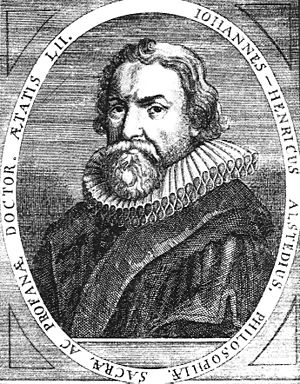Johann Heinrich Alsted facts for kids
Quick facts for kids
Johann Heinrich Alsted
|
|
|---|---|

1610 drawing of Alsted
|
|
| Born | March 1588 Mittenaar, Holy Roman Empire
|
| Died | 9 November 1638 |
|
Notable work
|
Encyclopaedia Cursus Philosophici |
| Era | Baroque philosophy |
| Region | Western philosophy
|
| Notable students | János Apáczai Csere |
|
Main interests
|
Pedagogy, encyclopaedia writing |
|
Influences
|
|
|
Influenced
|
|
Johann Heinrich Alsted (born March 1588 – died November 9, 1638) was an important German scholar. People called him "the true parent of all the Encyclopædias" because of his huge work in creating books of knowledge. He was a Transylvanian Saxon Calvinist minister and a university professor.
Alsted was interested in many subjects, including how to teach (called pedagogy) and how to create encyclopedias. He also studied theology (the study of religion). His friends noticed that an anagram of his Latin name, Alstedius, was sedulitas. This Latin word means "hard work," which perfectly described him!
Contents
Alsted's Life Story
Alsted was born in a place called Mittenaar in Germany. He went to school at Herborn Academy in the state of Hesse. There, he learned from a teacher named Johannes Piscator.
From 1606, he studied at the University of Marburg. His teachers included Rudolf Goclenius and Raphaël Egli. The next year, he moved to Basel to continue his studies. Around 1608, he returned to Herborn Academy. This time, he was a professor, teaching philosophy and theology.
Later in his life, Alsted had to leave Germany because of the Thirty Years' War. He moved to Transylvania, a region that is now part of Romania. He stayed there for the rest of his life.
In 1629, Alsted went to Weißenburg (now Alba Iulia). He helped start a new Calvinist Academy there. The leaders of Transylvania wanted to improve their schools, so they brought in professors like Alsted from Germany. One of his students there was János Apáczai Csere.
Alsted passed away in Alba Iulia in 1638.
Alsted's Important Works
The Encyclopedia Creator
Johann Heinrich Alsted is known as one of the most important encyclopedia writers ever. He wrote many books. His main Encyclopaedia, published in 1630, was very famous for a long time.
Before this big work, he wrote shorter ones, like the Encyclopaedia cursus philosophici in 1608. His major encyclopedia from 1630 was called Encyclopaedia, Septem Tomis Distincta. It was huge, divided into 35 books. It also had 48 summary tables and an index to help people find information.
Alsted described his encyclopedia as "a methodical systemization of all things which ought to be learned by men in this life." Simply put, he wanted it to contain "the totality of knowledge."
Many important people praised his work. Cotton Mather liked it, and it helped shape the ideas of Alsted's student, John Amos Comenius. Even the famous diarist Samuel Pepys bought a copy in 1660.
Some people, like Jacob Thomasius, said Alsted copied parts without saying where they came from. However, later, Augustus De Morgan called it "the true parent of all the Encyclopædias." This means it was a very important early example of what we now call an encyclopedia.
His Encyclopaedia was like a summary of everything people in Europe knew at that time. It included ideas from over 500 authors, from ancient thinkers like Aristotle to more recent ones.
Alstedius' Encyclopedia Biblica
In 1610, Alsted published the first version of his Encyclopedia Biblica. In 1630, he released a much bigger second edition. In this work, he tried to show that all knowledge, including arts and sciences, could be found in the Bible.
The first four books of this work explained different topics. Six books were about language studies (philology). Ten books covered deep thinking (speculative philosophy), and four were about practical matters. Then came books on religion (theology), law (jurisprudence), and medicine. He also included sections on mechanical arts, history, and other subjects. This work was a big improvement compared to other encyclopedias of its time.
The Logician
Alsted also wrote about logic, which is the study of correct reasoning. In 1614, he published Logicae Systema Harmonicum. He used his ideas about logic to organize all human knowledge in his encyclopedia.
He was known in his time for his unique way of organizing information. His methods combined ideas from different thinkers like Aristotle and Peter Ramus.
The Theologian
During his time in Transylvania, Alsted wrote a book called Prodromus. It was printed in 1641 but dated 1635. In this book, Alsted, as a Calvinist, argued against the ideas of Johannes Völkel. Völkel's work was against the idea of the Trinity, a key belief in Christianity. Alsted's book was a response to these different religious views.
See also
 In Spanish: Johann Heinrich Alsted para niños
In Spanish: Johann Heinrich Alsted para niños
- Encyclopaedia Cursus Philosophici

